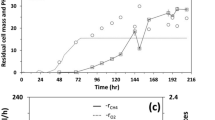Abstract
A newly isolated bacterium, designated as Klebsiella oxytoca M1, produced 2,3-butanediol (2,3-BDO) or acetoin selectively as a major product depending on temperature in a defined medium. K. oxytoca M1 produced 2,3-BDO mainly (0.32~0.34 g/g glucose) at 30 °C while acetoin was a major product (0.32~0.38 g/g glucose) at 37 °C. To investigate factors affecting product profiles according to temperature, the expression level of acetoin reductase (AR) that catalyzes the conversion of acetoin to 2,3-BDO was analyzed using crude protein extracted from K. oxytoca M1 grown at 30 and 37 °C. The AR expression at 37 °C was 12.8-fold lower than that at 30 °C at the stationary phase and reverse transcription PCR (RT-PCR) analysis of the budC (encoding AR) was also in agreement with the AR expression results. When AR was overexpressed using K. oxytoca M1 harboring pUC18CM-budC, 2,3-BDO became a major product at 37 °C, indicating that the AR expression level was a key factor determining the major product of K. oxytoca M1 at 37 °C. The results in this study demonstrate the feasibility of using K. oxytoca M1 for the production of not only 2,3-BDO but also acetoin as a major product.




Similar content being viewed by others
References
Garg, S. K., & Jain, A. (1995). Bioresource Technology, 51, 103–109.
Syu, M. J. (2001). Applied Microbiology and Biotechnology, 55, 10–18.
Ji, X. J., Huang, H., Du, J., Zhu, J. G., Ren, L. J., Hu, N., et al. (2009). Bioresource Technology, 100, 3410–3414.
Zhang, X., Yang, T. W., Lin, Q., Xu, M. J., Xia, H. F., Xu, Z. H., et al. (2011). World Journal of Microbiology and Biotechnology, 27, 2785–2790.
Werpy, T. and Petersen, G. (2004) Top value added chemicals from biomass volume I—results of screening for potential candidates from sugars and synthesis gas. U.S. Department of Energy.
Ji, X. J., Huang, H., Zhu, J. G., Ren, L. J., Nie, Z. K., Du, J., et al. (2010). Applied Microbiology and Biotechnology, 85, 1751–1758.
Ma, C., Wang, A., Qin, J., Li, L., Ai, X., Jiang, T., et al. (2009). Applied Microbiology and Biotechnology, 82, 49–57.
Zhang, L., Sun, J., Hao, Y., Zhu, J., Chu, J., Wei, D., et al. (2010). Journal of Industrial Microbiology and Biotechnology, 37, 857–862.
Jung, M. Y., Chiam, Y. N., Song, H., Lee, J., & Oh, M. K. (2012). Applied Microbiology and Biotechnology, 95, 461–469.
Ji, X. J., Huang, H., & Ouyang, P. K. (2011). Biotechnology Advances, 29, 351–364.
Wang, M., Fu, J., Zhang, X., & Chen, T. (2012). Biotechnology Letters, 34, 1877–1885.
Liu, Y., Zhang, S., Yong, Y. C., Ji, Z., Ma, X., Xu, Z., et al. (2011). Process Biochemistry, 46, 390–394.
Zhang, L., Chen, S., Xie, H., Tian, Y., & K, H. (2012). Journal of Chemical Technology and Biotechnology, 87, 1551–1557.
Kim, B., Lee, S., Park, J., Lu, M., Oh, M., Kim, Y., et al. (2012). Journal of Microbiology and Biotechnology, 22, 1258–1263.
Ahn, J. H., Sang, B. I., & Um, Y. (2011). Bioresource Technology, 102, 4934–4937.
Jeon, B. S., Kim, B. C., Um, Y., & Sang, B. I. (2010). Applied Microbiology and Biotechnology, 88, 1161–1167.
Altschul, S. F., Gish, W., Miller, W., Myers, E. W., & Lipmanl, D. J. (1990). Journal of Molecular Biology, 215, 403–410.
Chun, J., Lee, J. H., Jung, Y., Kim, M., Kim, S., Kim, B. K., et al. (2007). International Journal of Systematic and Evolutionary Microbiology, 57, 2259–2261.
Nicholson, W. L. (2008). Applied and Environmental Microbiology, 74, 6832–6838.
Jeong, K. J., Lee, H. S., Lee, S. Y., & Chang, Y. K. (1998). Biotechnology and Bioprocess Engineering, 3, 48–49.
Bradford, M. M. (1976). Analytical Biochemistry, 72, 248–254.
Moon, C., Ahn, J. H., Kim, S. W., Sang, B. I., & Um, Y. (2010). Applied Biochemistry and Biotechnology, 161, 502–510.
Shin, S. H., Kim, S., Kim, J. Y., Lee, S., Um, Y., Oh, M. K., et al. (2012). Journal of Bacteriology, 194, 2371–2372.
Acknowledgments
This research was supported by the R&D program of MKE/KEIT (no. 10035578, Development of 2,3-butanediol and derivative production technology for the C-zero bio-platform industry). The authors would like to thank Macrogen, Inc. for providing the full genome sequence of K. oxytoca M1.
Author information
Authors and Affiliations
Corresponding author
Electronic Supplementary Material
Below is the link to the electronic supplementary material.
Fig. S1
Phylogenetic tree based on 16S rDNA sequences showing the position of strain M1 among its closely related organisms. The scale bar represents 0.002 nucleotide substitutions per position (DOCX 122 kb)
Fig. S2
Fermentation profiles of K. oxytoca M1(pUC18CM) and K. oxytoca M1(pUC18CM-budC) at 37 °C with and without MES (a) the growth (OD600) (b) the residual glucose. Each data point represents the average of duplicate experiments (DOC 163 kb)
Rights and permissions
About this article
Cite this article
Cho, S., Kim, K.D., Ahn, JH. et al. Selective Production of 2,3-Butanediol and Acetoin by a Newly Isolated Bacterium Klebsiella oxytoca M1. Appl Biochem Biotechnol 170, 1922–1933 (2013). https://doi.org/10.1007/s12010-013-0291-2
Received:
Accepted:
Published:
Issue Date:
DOI: https://doi.org/10.1007/s12010-013-0291-2




